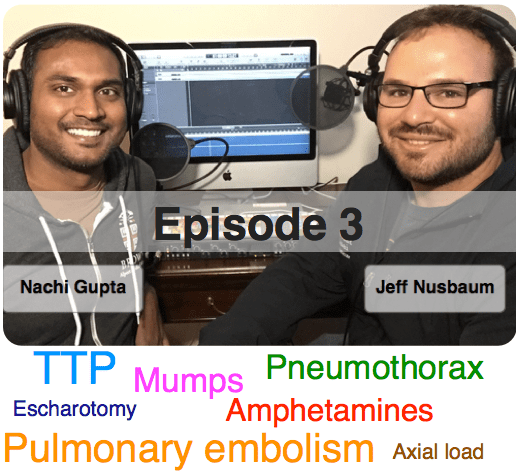Podcast Ep 3: Pulmonary Embolism, Pneumothorax, Axial Load Injury, & More

“The secret of getting ahead is getting started.” -Mark Twain
Hope you enjoyed ACEP as much as we did. Now it is time to get back to work. For current residents, the 2017 In-training Exam is scheduled for February 22nd. Do not forget to subscribe to RoshCast on your favorite podcast player, so new episodes will automatically be downloaded after release. Regular review and spaced repetition are the keys to success.
You can find our previous episodes here in case you missed them.
Remember, we appreciate any feedback you can provide. Please send it to feedback@roshreview.com
Lets get started…
Question 1
A 15-year-old boy presents to the ED after falling two stories down an elevator shaft. He complains of severe bilateral heel and back pain. On exam, he is alert with normal vital signs. His dorsalis pedis, popliteal, and femoral pulses are strong; no other deformity is recognized. Radiographs of the bilateral heels reveal calcaneal fractures. What additional test should be considered in this patient?
A. Compartment pressures
B. Complete radiographs of the spine
C. CT angiography
D. Retrograde urethrogram
Teaching card to supplement answer
Teaching card to supplement answer
Question 2
An 18-year-old man presents to the ED via the police because of altered mental status and violent behavior. The patient reportedly had been on a drug binge, using amphetamines and cocaine for the last two days. On arrival, he is afebrile, his heart rate is 140 beats per minute, blood pressure is 180/110 mm Hg, and he is respiring at 22 breaths per minute. He is agitated and combative, but there is no evidence of traumatic injury. His pupils are dilated, and he is diaphoretic. Which of the following statements is true regarding the treatment of amphetamine and cocaine toxicity?
A. Antipsychotics are the preferred initial therapy for agitation and psychosis
B. Beta-adrenergic blockers are safe for managing tachycardia and dysrhythmias
C. Body packers with leaking packets should receive whole-bowel irrigation
D. Vasodilators are first-line therapy for treating amphetamine-induced hypertension
E. Wide-complex tachydysrhythmias should be treated initially with sodium bicarbonate
Teaching card to supplement answer
Teaching card to supplement answer
Question 3
A 19-year-old man is brought in from a house fire. He has severe burns over a significant portion of his body. His right thigh has circumferential full-thickness burns and no palpable pulse in the foot. Where should an escharotomy be performed?
A. Anterior midline thigh
B. Circumferentially in the mid-thigh
C. Medial and lateral thigh
D. Posterior midline thigh
Teaching card to supplement answer
Teaching card to supplement answer
Question 4
Which of the following test results has the highest sensitivity for excluding pulmonary embolism?
A. Normal chest radiograph
B. Normal duplex ultrasound of the lower extremities
C. Normal helical computed tomography scan
D. Normal ventilation-perfusion nuclear medicine scan
Teaching card to supplement answer
Question 5
A 20-year-old man presents to the ED with left-sided pleuritic chest pain. The onset was sudden and occurred while he was washing dishes. Vital signs are BP 125/70 mm Hg, RR 16, HR 75, and pulse oximetry is 99% on room air. A chest radiograph is seen above. Which of the following is the most appropriate next step in management?
A. Left side thoracostomy with a 32-French tube
B. Needle decompression of the left chest
C. Non-rebreather mask at 15 liters oxygen/min
D. Repeat chest radiograph in 6 hours
Teaching card to supplement answer
Question 6
Which of the following is the hallmark characteristic of mumps?
A. Cough, coryza, and conjunctivitis
B. Epididymoorchitis
C. Maculopapular rash
D. Nonsuppurative parotid swelling
Teaching card to supplement answer

- Over 80% of calcaneal fractures are associated with concomitant vertebral fractures
- In amphetamine overdoses, wide complex tachydysrhythmias are treated with sodium bicarbonate. Don’t forget to address the underlying causes, and control the agitation with benzodiazepines and the hyperthermia with aggressive cooling measures.
- Body packers and stuffers who have ingested packets of drugs may undergo whole bowel irrigation only if the packets are intact. If they have ruptured, this becomes a surgical emergency.
- Escharotomies are performed along the medial and lateral aspects of both the upper and lower extremities in cases of circumferential burns
- Parkland formula: 4 x % total burned BSA x weight (in kg). Give the first half of the fluid over the first 8 hours and the second half of the fluid over the next 16 hours
- V/Q scan has the highest sensitivity for excluding pulmonary embolism
- The classic EKG finding with pulmonary embolism is S1Q3T3. Sinus tachycardia is the most common finding.
- A simple pneumothorax is one involving < 10% of the hemithorax and should be treated with a “non-rebreather” to increase the speed of resorption. With larger pneumothoraces, you may see a deep sulcus sign.
- Nonsuppurative parotid swelling is the hallmark characteristic of mumps
Please provide us feedback at feedback@roshreview.com Hopefully you enjoyed listening to this week’s episode and learned a thing or two as well. Don’t forget to subscribe to Roshcast on your favorite media player (iTunes, downcast, etc.) to ensure you will be the first to know about new episodes as they go up.
Until next time,
Jeff and Nachi
P.S. Please visit Rosh Review if you are looking for more high-quality emergency medicine board review.





Comments (0)